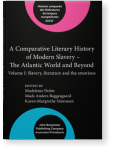Chapter 9
“No one can imagine my feelings”
The rhetoric of race, slavery, and emotional difference in the antebellum South
This chapter details the ideological foundations of the emotional norms of slavery and debates over
whether those practices and feelings were tied to race or to slave status. It examines how theories of racialized
emotional difference circulated, and the proslavery ramifications of those ideas, as well as how formerly enslaved
people used the medium of slave narratives to refute white supremacist ideas about their affective inferiority and
subvert the expectations of sentimental audiences. Abolitionists’ argument that emotional differences were rooted in
slave status, not race, jeopardized proslavery ideology and individual slaveholders, as it meant that after
Emancipation, black people would expect the same emotional liberty as free people.
Article outline
- Transient griefs and beastly cruelty
- Social constructs and biological imperatives
- The feelings of a freeman
- Feelings only a slave can imagine
- Feelings no words can express
- A stranger to sensibility
- Conclusion
-
Notes
-
References
This content is being prepared for publication; it may be subject to changes.
